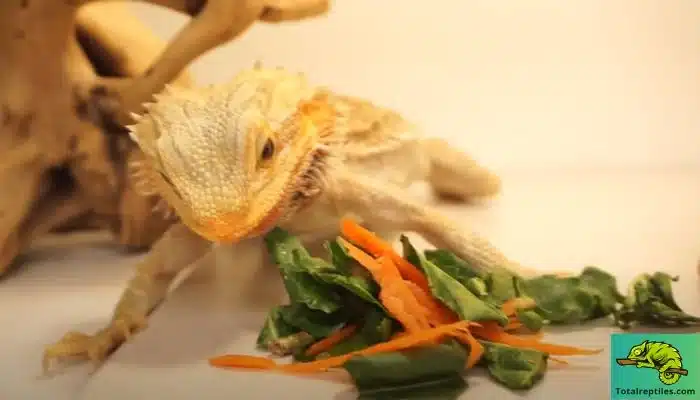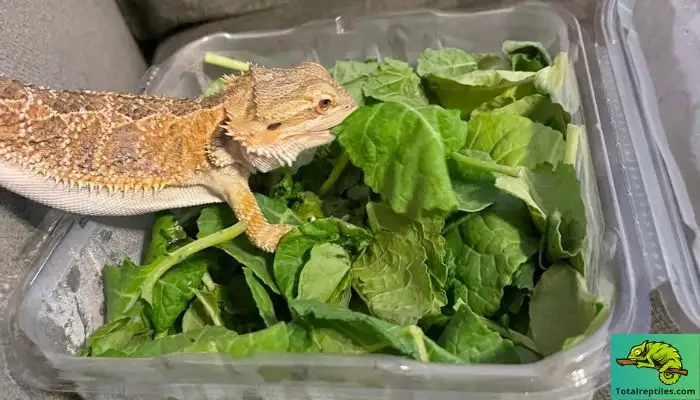Yes, bearded dragons can eat spring mix, a combination of fresh vegetables. Spring mix, sometimes called spring greens, is a blend of young, tender salad greens often used in salads. This typical mix salad includes baby spinach, arugula, lettuce, and other leafy greens. Its variety of nutrient-dense leaves could be a healthy addition to a bearded dragon’s diet.
When researching what to feed the BD, you may have encountered spring mix as a potential food item. But can bearded dragons eat spring mix?
In this blog post, I’ll draw from my many years of experience caring for beardies to provide a specific answer. I’ll analyze nutritional value and recommend whether it should be part of a beardie’s diet.

Nutritional Benefits Of Spring Mix For Bearded Dragons
Bearded dragons can eat spring mix greens in moderation as part of a varied diet. Here are some of the benefits that can make a nutritious addition to your pet’s diet:
- Vitamin A– Spring mix often contains leafy greens like spinach and lettuce, which provide vitamin A, an essential nutrient for bearded dragons. Vitamin A supports healthy eyes, skin, and skeletal growth.
- Calcium – Calcium is critical to maintaining strong bones and preventing metabolic bone disease. Many common mixed ingredients supply calcium, including spinach, dandelion greens, and rockets.
- Antioxidants– The leafy greens mix contains antioxidants like vitamin C and beta carotene. These help neutralize damaging free radicals and the immune system.
- Water– Hydration is vital for BD, and the high water content in fresh spring mix greens can help keep pets hydrated.
- Fiber – Fiber aids digestion in bearded dragons, and the fiber-rich greens can support the pet’s gastrointestinal health.
Spring mix salad can boost key vitamins, minerals, and nutrients bearded dragons need. It can be eaten with vegetables, fruits, and insects for a complete diet.
Can Bearded Dragons Eat Spring Mix Daily?
Unfortunately, spring mix may not be the best option as a daily green for bearded dragons for the following reasons:
- Contains oxalic acid – Some greens in spring mix, like spinach, contain oxalic acid, which can bind to calcium and cause toxicity when overconsumed.
- Presence of goitrogens – Goitrogenic compounds in spinach may affect thyroid function if fed daily over time.
- Low in fiber – Since the mix contains tender young greens, the fiber content is relatively low.
- Calcium-phosphorus ratios – These minerals are not ideal for properly meeting the bearded dragon diet.
- Diarrhea – Too much spring mix could lead to loose stool or diarrhea, especially in younger dragons. This is due to the high water content.
Because of these drawbacks, spring mix is likely best limited to 2-3 times per week in rotation with more balanced salad staples. Feed mix salad in conservative amounts to prevent these risks, and stick to a varied diet.
How Much Spring Mix Can Bearded Dragon Eat?
It’s important not to overdo it when offering spring-mix bearded dragons. Some recommended spring mix portion sizes based on age:
- Baby dragons: Start with 1-2 small leaves per serving.
- Juveniles & subadults: Approximately 2-3 leaves per serving.
- Full-grown adults: Around 3-4 leaves per serving.
Closely monitor your dragon’s appetite and reduce portions if they seem disinterested. Never exceed four leaves in one sitting due to the potential for excess oxalates.
How Often Can Bearded Dragon Eat Spring Mix?
For most bearded dragons, spring mix is best limited to 2-3 times weekly. This allows them to reap benefits from the nutrients. Here’s a sample routine:

- Monday – Collard or dandelion greens
- Tuesday – Spring mix
- Wednesday – Kale or mustard greens
- Thursday – Bok choy or green beans
- Friday – Spring mix
- Saturday – Escarole or Endive
- Sunday – Chard or carrot tops
This type of varied schedule allows for a nutritional balance. Monitor your dragon’s preferences and adjust their salads accordingly.
Can bearded reptiles eat canned spring mix?
The Pennsylvania State University report indicates that canning effectively retains the flavor and most of the food’s nutrients. But It’s best to skip canned or frozen versions. The canning process often strips away nutrients and enzymes that fresh produce contains.
Additionally, canned greens have a different, mushier texture than fresh greens. This can be sickening and harder for beardies to digest correctly.
Always choose a fresh spring mix for the highest nutritional value and best texture.
How To Prepare Spring Mix For Bearded Dragon?
To safely provide spring mix for bearded dragons, follow these tips for storage, preparation, and feeding:

- Seek out the fresh, organic reptile-formulated mix or make your blend.
- Wash thoroughly to remove any pesticides or contaminants.
- Chop into smaller, bite-sized pieces for easier eating.
- Mix in some additional veggies like shredded carrots for texture.
- Lightly dust with calcium powder before feeding.
- Portion the appropriate amount based on the dragon’s age and weight.
- Discard uneaten greens after 24 hours.
Following this preparation routine will help make spring mix a tasty and healthy addition to the bearded dragon’s diet when fed properly.
Conclusion
Spring mix can offer beneficial nutrition as part of a balanced diet for bearded dragons. The blend of tender greens provides key vitamins, minerals, water, and fiber. This salad mix should not be a staple food. Limit feedings to a few times per week and moderate portion sizes to prevent nutritional imbalances or diarrhea.
Combine small amounts of spring mix with vegetables, healthy fruits, insects, and calcium supplements. Rotating various fresh salad greens like collard, mustard, and turnip greens helps give bearded dragon diet diversity.

